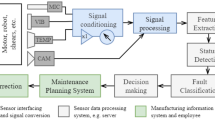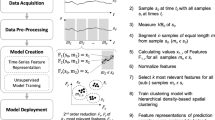Abstract
The objective of this work is to tackle the challenges of monitoring and detecting subtle process changes in chemical mechanical planarization (CMP), an ultraprecision manufacturing process. Monitoring ultraprecision processes is usually of difficulty due to their innate complexity and low signal-to-noise ratio in sensor signals. Especially for subtle signal variations during small process changes, the conventional statistical process control charts could fail to detect such process anomalies from the sensor signals in the time domain. In this paper, frequency spectra representation of the microelectromechanical systems (MEMS) vibration sensor signals during subtle process changes is investigated, and the signal patterns uncovered by frequency spectra are utilized to formulate a machine learning–driven in situ process monitoring approach to detect process anomalies in CMP. The proposed approach overcomes the obstacles of differentiating subtle signal changes by transforming them into the frequency domain with Fourier transform and Hilbert-Huang transform and classifying the resulted frequency spectra with random forest. Based on frequency analysis, it can unveil the differences in the signals obscured in the time domain and suppress the high-frequency noise. Consequently, the presented machine learning–driven in situ process monitoring approach detects process anomalies by differentiating the deviated frequency spectra with machine learning. It is validated on our experimental CMP testbed for anomaly detection, and outperforms three benchmark statistical process control charts. For instance, it detects a slurry shutoff anomaly in CMP about ten times faster than the benchmark methods.










Similar content being viewed by others
References
Bengio Y (2009). Learning Deep Architectures for AI. Foundations and Trends in Machine Learning (Found. Trends Mach. Learn.) 2(1):1–127. https://doi.org/10.1561/2200000006
Berman M, Bibby T, Smith A (1998) Review of In Situ & in-line detection for CMP applications. Semiconductor Fabtech 267–274
Bishop C (1996) Neural networks for pattern recognition. Oxford University Press, New York
Bishop CM (2006) Pattern recognition and machine learning. Springer, New York, NY
Blackman RB, Tukey JW (1958) The measurement of power spectra from the point of view of communications engineering—part I. Bell Syst Tech J 37:185–282
Bracewell RN, Bracewell RN (1986) The Fourier transform and its applications. McGraw-Hill, New York
Breiman L (2001) Random forests. Mach Learn 45:5–32
Chakraborti S, Van der Laan P, Bakir S (2001) Nonparametric control charts: an overview and some results. J Qual Technol 33:304–315
Choi SW, Park JH, Lee I-B (2004) Process monitoring using a Gaussian mixture model via principal component analysis and discriminant analysis. Comput Chem Eng 28:1377–1387
Ganesan R, Das TK, Sikder AK, Kumar A (2003) Wavelet-based identification of delamination defect in CMP (Cu-low k) using nonstationary acoustic emission signal. IEEE Trans Semicond Manuf 16:677–685
Ganesan R, Das TK, Venkataraman V (2004) Wavelet-based multiscale statistical process monitoring: a literature review. IIE Trans 36:787–806
Gao J, Hu G, Yao X, Chang R (2006) Anomaly detection of network traffic based on wavelet packet. 2006 Asia-Pacific Conference on Communications 1–5
Gao Y, Gao B, Chen Q, Liu J, Zhang Y (2020) Deep convolutional neural network-based epileptic electroencephalogram (EEG) signal classification. Frontiers in neurology 11:375. https://doi.org/10.3389/fneur.2020.00375
Guo H, Paynabar K, Jin J (2012) Multiscale monitoring of autocorrelated processes using wavelets analysis. IIE Trans 44:312–326
Hariharan H, Gribok A, Abidi MA, Koschan A (2006) Image fusion and enhancement via empirical mode decomposition. J Pattern Recognit Res 1:16–32
Hotelling H (1933) Analysis of a complex of statistical variables into principal components. J Educ Psychol 24:417–441
Huang H, Pan J (2006) Speech pitch determination based on Hilbert-Huang transform. Signal Process 86:792–803
Huang NE, Shen Z, Long SR, Wu MC, Shih HH, Zheng Q, Yen N-C, Tung CC, Liu HH (1998) The empirical mode decomposition and the Hilbert spectrum for nonlinear and nonstationary time series analysis. Proc R Soc London Ser A 454:903–995
Jeong MK, Lu J-C, Wang N (2006) Wavelet-based SPC procedure for complicated functional data. Int J Prod Res 44:729–744
LeCun Y, Bottou L, Bengio Y, Haffner P (1998) Gradient-based learning applied to document recognition. Proc IEEE 86:2278–2324
Liaw A, Wiener M (2002) Classification and regression by randomForest. R News 2:18–22
Liu J, Beyca O, Rao P, Kong Z, Bukkapatnam S (2017a) Dirichlet process Gaussian mixture models for real-time monitoring and their application to chemical mechanical planarization. IEEE Trans Autom Sci Eng 14:208–221
Liu J, Jin R, Kong Z (2018) Wafer quality monitoring using spatial Dirichlet process based mixed-effect profile modeling scheme. J Manuf Syst 48:21–32
Liu JP, Beyca OF, Rao PK, Kong ZJ, Bukkapatnam ST (2017b) Dirichlet process Gaussian mixture models for real-time monitoring and their application to chemical mechanical planarization. IEEE Trans Autom Sci Eng 14:208–221
Lu J-C, Jeng S-L, Wang K (2009) A review of statistical methods for quality improvement and control in nanotechnology. J Qual Technol 41:148–164
Martis RJ, Acharya UR, Tan JH, Petznick A, Yanti R, Chua CK, Ng EK, Tong L (2012) Application of empirical mode decomposition (EMD) for automated detection of epilepsy using EEG signals. Int J Neural Syst 22:1250027
Montgomery DC (2008) Introduction to statistical quality control, 6/Ed. John Wiley & Sons, New York
Nishi Y, Doering R (2000) Handbook of semiconductor manufacturing technology. CRC Press, Boca Raton
Noiboar A, Cohen I (2007) Anomaly detection based on wavelet domain GARCH random field modeling. IEEE Trans Geosci Remote Sens 45:1361–1373
Oppenheim AV (1999) Discrete-time signal processing. Pearson Education, Bengaluru
Karl Pearson F.R.S. (1901) LIII. On lines and planes of closest fit to systems of points in space, The London, Edinburgh, and Dublin Philosophical Magazine and Journal of Science (London, Edinburgh Dublin Philos. Mag. J. Sci.), 2:11, 559-572, https://doi.org/10.1080/14786440109462720
Pugh GA (1991) A comparison of neural networks to SPC charts. Comput Ind Eng 21:253–255
Qiu P (2013) Introduction to statistical process control. CRC Press, Boca Raton
Qiu P, Li Z (2011a) Distribution-free monitoring of univariate processes. Statist Probab Lett 81:1833–1840
Qiu P, Li Z (2011) On nonparametric statistical process control of univariate processes, technometrics 53(4):390–405. https://doi.org/10.1198/TECH.2011.10005
Rao P, Bukkapatnam S, Beyca O, Kong ZJ, Komanduri R (2014a) Real-time identification of incipient surface morphology variations in ultraprecision machining process. J Manuf Sci Eng 136:021008-1–021008-11
Rao PK (2013) Sensor-based monitoring and inspection of surface morphology variations in ultraprecision manufacturing processes. Oklahoma State University, Stillwater
Rao PK, Bhushan MB, Bukkapatnam ST, Kong Z, Byalal S, Beyca OF, Fields A, Komanduri R (2014b) Process-machine interaction (PMI) modeling and monitoring of chemical mechanical planarization (CMP) process using wireless vibration sensors. IEEE Trans Semicond Manuf 27:1–15
Rao PK, Liu J, Roberson D, Kong Z, Williams CB (2015) Online real-time quality monitoring in additive manufacturing processes using heterogeneous sensors. J Manuf Sci Eng 137:061007
Steigerwald JM, Murarka SP, Gutmann RJ (2008) Chemical mechanical planarization of microelectronic materials. Wiley-VCH, Weinheim
Thissen U, Swierenga H, De Weijer A, Wehrens R, Melssen W, Buydens L (2005) Multivariate statistical process control using mixture modelling. J Chemom 19:23–31
Van Loan C (1992) Computational frameworks for the fast Fourier transform. Siam
Zhang RR, Ma S, Safak E, Hartzell S (2003) Hilbert-Huang transform analysis of dynamic and earthquake motion recordings. J Eng Mech 129:861–875
Zheng J, Fushing H, Ge L (2019) A data-driven approach to predict and classify epileptic seizures from brain-wide calcium imaging video data, IEEE/ACM Transactions on Computational Biology and Bioinformatics. https://doi.org/10.1109/TCBB.2019.2895077
Zheng J, Liang M, Ekstrom A, Ge L, Yu W, Hsieh F (2018) On association study of scalp EEG data channels under different circumstances. In: Chellappan S, Cheng W, Li W (eds) Wireless Algorithms, Systems, and Applications. WASA 2018. Lecture Notes in Computer Science, vol 10874. Springer, Cham. https://doi.org/10.1007/978-3-319-94268-1_56
Zorriassatine F, Tannock J (1998) A review of neural networks for statistical process control. J Intell Manuf 9:209–224
Author information
Authors and Affiliations
Corresponding author
Additional information
Publisher’s note
Springer Nature remains neutral with regard to jurisdictional claims in published maps and institutional affiliations.
Rights and permissions
About this article
Cite this article
Liu, J.(., Zheng, J., Rao, P. et al. Machine learning–driven in situ process monitoring with vibration frequency spectra for chemical mechanical planarization. Int J Adv Manuf Technol 111, 1873–1888 (2020). https://doi.org/10.1007/s00170-020-06165-1
Received:
Accepted:
Published:
Issue Date:
DOI: https://doi.org/10.1007/s00170-020-06165-1




